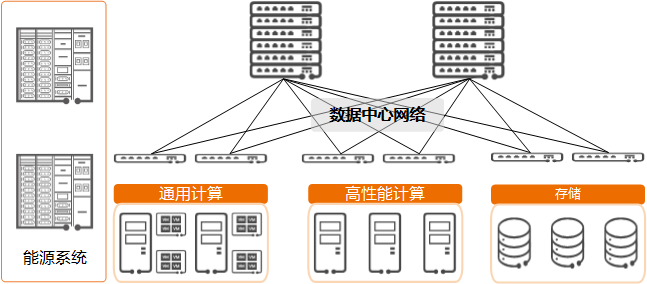
What is Data Center Interconnection Technology?
- Categories:Industry News
- Time of issue:2022-07-22
(Summary description) Data Center Interconnect (DCI) is a network solution that realizes interconnection between multiple data centers. Data centers are important infrastructure for digital transformation. With the rise of cloud computing, big data, and artificial intelligence, enterprise data centers are increasingly used. In order to meet the needs of scenarios such as cross-regional operation, user access, and remote disaster recovery, more and more organizations and enterprises deploy multiple data centers in different regions. At this time, it is necessary to interconnect multiple data centers with 25G BiDi LR. What is a data center? The data center is responsible for the calculation, storage and forwarding of data, and is the most critical digital infrastructure in the new infrastructure. A modern data center mainly includes the following core components: Computing systems, including general computing modules for deploying services and high-performance computing modules that provide super computing power. Storage system, including mass storage modules, data management engine, storage dedicated network, etc. Energy system, including power supply module, temperature control module, IT management module, etc. The data center network is responsible for connecting general computing, high-performance computing and storage modules within the data center, and all data interactions between them must be realized through the data center network. Among them, the general computing module directly undertakes the user's business, and the physical basic unit it relies on is a large number of servers. If the server is the body of the data center, then the data center network is the soul of the data center, 25G BiDi LR.
What is Data Center Interconnection Technology?
(Summary description) Data Center Interconnect (DCI) is a network solution that realizes interconnection between multiple data centers. Data centers are important infrastructure for digital transformation. With the rise of cloud computing, big data, and artificial intelligence, enterprise data centers are increasingly used. In order to meet the needs of scenarios such as cross-regional operation, user access, and remote disaster recovery, more and more organizations and enterprises deploy multiple data centers in different regions. At this time, it is necessary to interconnect multiple data centers with 25G BiDi LR.
What is a data center?
The data center is responsible for the calculation, storage and forwarding of data, and is the most critical digital infrastructure in the new infrastructure. A modern data center mainly includes the following core components:
Computing systems, including general computing modules for deploying services and high-performance computing modules that provide super computing power.
Storage system, including mass storage modules, data management engine, storage dedicated network, etc.
Energy system, including power supply module, temperature control module, IT management module, etc.
The data center network is responsible for connecting general computing, high-performance computing and storage modules within the data center, and all data interactions between them must be realized through the data center network.
Among them, the general computing module directly undertakes the user's business, and the physical basic unit it relies on is a large number of servers. If the server is the body of the data center, then the data center network is the soul of the data center, 25G BiDi LR.
- Categories:Industry News
- Time of issue:2022-07-22
- Views:
Data Center Interconnect (DCI) is a network solution that realizes interconnection between multiple data centers. The data center is an important infrastructure for digital transformation. With the rise of cloud computing, big data, and artificial intelligence, enterprise data centers are increasingly widely used. In order to meet the needs of scenarios such as cross-regional operation, user access, and remote disaster recovery, more and more organizations and enterprises deploy multiple data centers in different regions. At this time, multiple data centers need to be interconnected 25G BiDi LR.
What is a data center?
The data center is responsible for the calculation, storage and forwarding of data, and is the most critical digital infrastructure in the new infrastructure. A modern data center mainly includes the following core components:
Computing systems, including general computing modules for deploying services and high-performance computing modules that provide super computing power.
Storage system, including mass storage modules, data management engine, storage dedicated network, etc.
Energy system, including power supply module, temperature control module, IT management module, etc.
The data center network is responsible for connecting general computing, high-performance computing and storage modules within the data center, and all data interactions between them must be realized through the data center network.

Among them, the general computing module directly undertakes the user's business, and the physical basic unit it relies on is a large number of servers. If the server is the body of the data center, then the data center network is the soul of the data center 25G BiDi LR.
Scan the QR code to read on your phone
Related
-
New products | Sunstar announced: 50G PON three-mode combo OLT miniaturized optical device for SFP and QSFP packages
With the popularization of gigabit broadband, 10G PON has entered the stage of large-scale deployment. At the same time, the industry is also laying out 50G PON to prepare for the 10-gigabit era. Compared with 10G PON, the 50G PON standard provides five times more access bandwidth and better service support capabilities (large bandwidth, low latency, and high reliability). At the same time, for operators, the biggest problem facing the commercial use of 50G PON is the problem of multi-generation coexistence. ITU-T standards provide different options for the differentiated deployment of global operators. GPON region, G.9804.1 Amd2 and G.9805 offer 2 classes /5 options; EPON area, provides 2 types /4 options. From this point of view, multi-generation coexistence is an inevitable choice in the continuous evolution of the next generation PON. Sunstar Communication Technology Co.,Ltd.released 50G PON three-mode Combo OLT miniaturized optical device, which is MPM (built-in combined wave) 3-generation wave division mode coexistence, that is, G/XG(S)/50G three-mode MPM. The advantage of this solution is that the traditional gateway devices can be reused without changing or upgrading the user side, and the upgrade process can be optimized, equipment occupation and equipment room space can be saved, and energy consumption can be reduced. This three-mode Combo OLT miniaturized optical device uses a novel optical path design and a miniaturized TO-CAN package solution, and uses the technology accumulation and quality control of Sunstar Company in the field of coaxial packaging for many years, combining precision manufacturing, multi-wavelength spectrographic design and various types of TO-CAN package technology perfectly together. The 50G PON three-mode Combo OLT compact optical device of Sunstar Company is characterized by small size, high coupling efficiency, high structural reliability and strong manufacturability in mass production. The most critical is that its optimized optical path design and special packaging process ensure the upstream three-wavelength splitting, especially the isolation index of 50G PON upstream wavelength and GPON upstream wavelength, that is, the isolation degree of 1286±2nm and 1310±20nm edge wavelength; And take into account the high coupling efficiency of the downgoing three-way emitting laser to ensure the best output optical power index. This optical device is fully suitable for SFP and QSFP module packages, helping the access network to smoothly evolve to 50G PON. The 49th Optical Networking and Communications Symposium and Expo (OFC 2024) will be held from March 26 to 28, 2024 at the San Diego Convention Center, California, USA. The company will bring 10G PON OLT, 25G PON OLT, 50G PON OLT three-mode, 400G ER4 TOSA & ROSA, 800G DR8 optical module and a full range of AOC optical module solutions to the exhibition, welcome to visit the #3841 booth. About Sunstar Founded in 2001, Sunstar Communication Technology Co.,Ltd. focuses on the design, development, manufacturing, sales and technical support services of Optical Transceiver (OSA). After 20 years of technology accumulation and development, the formation of optical path, mechanical structure, high frequency simulation, thermal simulation, circuit, FPC soft board, IT software automation and other core technology design platform, and with precision machining, passive components, SMT, TO-CAN, OSA optical devices, COB, BOX, optical module the whole industry chain production and manufacturing capabilities. The company operates in China, North America, Europe, and Southeast Asia, and is also a subsidiary of the world's leading provider of optical fiber, cable and integrated solutions,YOFC Optical Fiber and Cable Co., LTD. - OFC2024 | Sunstar sincerely invites you to visit #3841 for negotiation and guidance 03-22
- Sunstar Combo 50G & XGS & GPON OLT QSFP-DD light module won the 2023 ICC "Excellent Technology Award" 01-10
- Tel:86-(0)28-87988088
- Fax:86-(0)28-87988568
- Address:4F.,Blog.D1,Mould lndustrial Park West High-tech Zone,Chengdu,Sichuan,P.R.C
Sunstar Communication Technology Co.,Ltd
Copyright © 2020 Sunstar Communication Technology Co.,Ltd All Rights Reserved 蜀ICP备19023203号-1














 Scan code
Scan code


